
Circle’s French entity is launching USDC and EURC issuance in the EU in compliance with one of the world’s most comprehensive regulatory regimes for digital assets
Circle, a global financial technology firm and the issuer of USDC and EURC, has announced that it has become the first global stablecoin issuer to achieve compliance with the European Union’s landmark Markets in Crypto-Assets (MiCA) regulatory framework.
This achievement was enabled by the company’s attainment of an Electronic Money Institution (EMI) license (’agrément en qualité d’établissement de monnaie électronique) from the Autorité de Contrôle Prudentiel et de Résolution (ACPR), the French banking regulatory authority. With this license, both USDC and EURC are now being issued in the EU in compliance with MiCA’s regulatory obligations for stablecoins or e-money tokens, which took effect yesterday.
As part of attaining compliance with this comprehensive regulatory regime, Circle Mint is officially available for business customers in Europe. Equipped with local banking capabilities, Circle Mint France provides near-instant and cost-effective access to mint and redeem USDC and EURC throughout the European market.
“Since our founding, Circle has sought to build durable, compliant, and well-regulated infrastructure for stablecoins, and our adherence to MiCA, which represents one of the most comprehensive crypto regulatory regimes in the world, is a huge milestone in bringing digital currency into mainstream scale and acceptance,” said Jeremy Allaire, Co-Founder and Chief Executive Officer at Circle. “By working closely with French and EU regulators, we are now able to offer both USDC and EURC as fully-compliant dollar and euro stablecoins to the European market, unlocking the enormous potential of digital assets to transform finance and commerce.”
“Achieving MiCA compliance through our French EMI license is a significant step forward, not just for Circle, but for the entire digital financial ecosystem in Europe and beyond,” said Dante Disparte, Chief Strategy Officer and Head of Global Policy at Circle. “As digital assets become increasingly integrated into the mainstream financial landscape, it is essential that we establish robust, transparent frameworks to promote trust and adoption. Today’s announcement further reinforces our commitment to building a more inclusive, compliant future for internet finance.”
Of the top 10 stablecoins by market capitalization, only USDC is currently MiCA-compliant. This milestone underscores Circle’s commitment to regulatory compliance for dollar and euro stablecoins. The company’s proactive approach to meeting high standards of security, transparency and oversight will help drive the mainstream adoption of regulated digital currencies.
Source: Circle
nothing to see here: just the complete digitization of the European economic zone https://t.co/h0hgT4L16R
— Matthew Stotts (🌊,🌲) (@mlstotts) July 1, 2024
Jeremy Allaire, co-founder & CEO of Circle, said on X:
“BREAKING NEWS:
@Circle announces that USDC and EURC are now available under new EU stablecoin laws; Circle is the first global stablecoin issuer to be compliant with MiCA. Circle is now natively issuing both USDC and EURC to European customers effective July 1st. Details below….
Today’s announcement from Circle is a major milestone in the ongoing development of the internet financial system, with one of the largest economies in the world having established clear regulations that make stablecoins legal electronic money, and ushering in a phase in the crypto market’s development as a mainstream infrastructure for payments, finance and commerce.
It’s incredibly gratifying to witness this moment in the evolution and adoption of digital currency. Some 11 years ago when we started Circle, it was with a clear vision that blockchain networks would make it possible to issue fully-reserved fiat digital currency that could operate on open and interoperable public networks, enabling a transformation in value exchange similar to the transformation that open networks brought to information publishing and communications.
At that time, we knew if we were to succeed in realizing our vision two things needed to happen: first, blockchain tech needed to evolve massively (e.g. we needed chains where you could issue tokens, execute code in the form of smart contracts, build actual money protocols on blockchains, and scalable infrastructure); and second, new policies and laws would need to be established, likely globally, for how what we think of as money (e.g. cash, government bonds, HQLAs) could connect to this new kind of open, programmable public network infrastructure.
Circle was the first crypto company to receive Electronic Money Transmission Licenses throughout the US, the first crypto company to receive a New York BitLicense, the first crypto company to receive an E-Money Issuance license in the UK, and we pioneered early models for how fiat could work on public chains (initially over Bitcoin). Back then all of this was considered incredibly niche, the mainstream financial sector was hostile to all of it, and the entire concept of fiat digital currency did not really even exist outside of very early crypto circles. The concept of seeing major global laws that enshrined stablecoins into the financial system was inconceivable.
Then, six years ago, in 2018, the technology of Ethereum made building a “protocol for dollars on the internet” or an “HTTP for Money” a real possibility, and in May of 2018 we announced, and then later launched USDC, a protocol for dollars on the internet. Working with payments regulators throughout the US, we brought this innovation in electronic money onto public blockchains with a protocol that developers could build on, automate and integrate into smart contract applications. With nearly immediate product market fit (the birth of DeFi, and the rapid growth of stablecoins on digital asset exchanges), this whole category began to grow, albeit from a tiny base of usage.
Shortly after our launch of USDC, the world’s largest internet company by end-users, Facebook, announced their intention to enter the global stablecoin market with Project Libra, a synthetic global currency they intended to launch to their 3 billion user customer base. Facing nearly immediate and hostile backlash from governments around the world, the project came under intense scrutiny, and spawned an effort first at the G7 and then through the G20 and the Financial Stability Board to develop a global regulatory approach to stablecoins.
Not long after, just 4 years ago, two major developments occurred: First, the work of the global regulatory community culminated in a set of G20 Policy Recommendations for stablecoins, which were later ratified at the G20 and sent on to member countries to bring into law through their policy and regulatory apparatus’.
Second, the bottoms-up, open internet and open ecosystem innovations like USDC surged in growth alongside explosive growth and interest in blockchains and crypto assets. USDC grew 1000% two years straight, from 400M to 4B to 40B, and the infrastructure around crypto matured rapidly as well, with the advent of 3rd generation blockchains and the rise of onchain finance and payments.
Major governments (the US, EU, Singapore, Japan, and many others) began to move more swiftly on the policy front, with leadership in the EU and US both pushing for the rapid introduction of regulations for stablecoins and crypto asset markets. Then, nearly 2 years ago to this day, the EU institutions reached a deal on the Markets in Crypto Assets (MiCA) regime, which was finally approved by the EU Parliament’s plenary – and also entered into force – last year. MiCA sets forth the world’s most comprehensive regulations for stablecoins and digital asset markets.
And, on that same day as MiCA being agreed on, Circle announced our initial launch of a Euro Stablecoin, along with a statement of our full intention to bring our stablecoins into compliance with these new and critical regulations for the European Union.
As many people know, France was – and continues to be – at the forefront of establishing clear regulations around crypto and digital assets, with early French laws regulating crypto trading firms, crypto custody and rules for issuing and selling digital tokens. The French government took a leading role not just in France, but ultimately, under the French Presidency of the EU – they helped to usher in an EU-wide regulatory framework that in many ways was inspired by earlier innovation-forward French policies.
Circle determined quickly that we should choose France as our new European headquarters for launching our regulated stablecoin and digital asset businesses. That choice has proven wise – we have been able to work extremely hard over the past two years with the ACPR to bring Circle’s business into the EU and under the new comprehensive regulatory regime of MiCA.
Our Announcement
I am delighted to share that Circle is authorized as an E-Money Issuer by the ACPR in France, and a MiCA-compliant E-Money Token issuer for both USDC and EURC. Circle France is now home to the headquarters of our European regulated financial activity, and European customers can now directly access USDC and EURC via Circle Mint France.
USDC has become the first and only major global stablecoin to be compliant and available under the new stablecoin regulatory regime in Europe. We have worked intensively with French, EU and US prudential regulators to clarify how a global stablecoin such as USDC can be issued out of BOTH the US and Europe, while maintaining complete fungibility on blockchain networks.
This is a major breakthrough and reflects creativity, hard work and a spirit of trying to both embrace a major technical innovation (fungible, globally available digital currency) while meeting stringent and important regulatory standards to ensure the safety and soundness of these electronic money tokens for persons across different regimes.
What does this mean for customers today?
All USDC and EURC currently in circulation in Europe are officially MiCA compliant, with Circle now holding 100% of EURC reserves under our regulated Circle France entity, and similarly holding the necessary reserves for European USDC holders within the EU with a Global Systemically Important Bank (GSIB).
All of the USDC held by Europeans remains fully fungible globally, and users can trade, transact, self-custody, use in DeFi, etc. with no changes. For the vast majority of European users who purchase, hold or sell USDC or EURC on an exchange or other crypto asset service provider’s product, nothing changes.
Effectively immediately, Circle is now issuing and redeeming USDC and EURC directly with major institutions in the European market via Circle Mint France. This includes exchanges, market makers, brokerages, consumer wallets, fintechs and payment institutions, banks and large enterprises.
Alongside our launch, you will begin to see a series of announcements from the entire global digital asset ecosystem who are adopting USDC and EURC as the preferred regulated stablecoins on their platforms and services, as Circle is the only global issuer who is able to provide these stablecoins in a fully compliant manner.
What is changing, of course, is that Circle’s stablecoins are now under the direct supervision of prudential regulators in Europe, namely the ACPR here in France, following detailed prudential standards, the so-called MiCA level two legislation, developed by the European Banking Authority. European users are afforded the protections brought from MiCA, ensuring safe and sound reserves, fully audited financial statements, prudential risk management, strict compliance with financial crimes and anti-money laundering rules, and detailed public reporting.
Impact on the Global and European Digital Assets Market
For nearly a year, and with increasing intensity over the past months, the global digital asset industry has been scrambling to understand the impact of MiCA, the world’s first and most comprehensive crypto regulatory regime that ultimately spans a market with nearly 450 million customers.
With stablecoins, especially dollar stablecoins, becoming the bedrock of digital asset markets, major global exchanges and crypto asset services providers (CASPs) with European customers, as well as 100% of European-based CASPs, have been highly focused on how the market will unfold and whether any major dollar stablecoin would be able to continue functioning with this new comprehensive regulatory regime. That question has now been decisively answered, and the world’s leading, regulated digital dollar, USDC, is now available in the EU, and we hope and expect it will become the leading dollar stablecoin in the region.
However, this moment portends a much broader market structure shift that we believe is going to accelerate over the next year, as major jurisdictions ranging from Japan, the US, UK, Singapore, Hong Kong, the UAE, Brazil, and many other major markets and economies also go live with comprehensive stablecoin rules, all of which require stringent regulatory compliance, and where dollar stablecoins in particular must be issued under a burden of regulatory equivalence.
Circle has built the infrastructure necessary to deliver USDC as a fungible digital dollar that can meet the emerging regulatory requirements of diverse global jurisdictions. It is during moments such as this that the entire global digital asset industry should be reflecting on what their future looks like, what the expectations for responsible innovation entail, and work towards operating products and services built on the strongest foundation possible.
Impact on the Adoption of Euro Stablecoins and Stablecoins More Broadly
One of the most significant and exciting things that this moment entails is the almost certain growth in and adoption of Euro digital currency in the form of Euro stablecoins. By establishing a clear rulebook for the issuance and operations of Euro digital currency, these new laws will foster a highly competitive market for Euro digital currency, with banks and EMIs both able to issue and utilize Euro stablecoins as a core part of their products and services.
This means that the entire European regulated financial sector can now adopt blockchain-native financial infrastructure, which will significantly expand the utility of stablecoins in commerce and finance. We are already seeing significant and accelerating interest in EURC from major enterprises, large financial institutions, payments firms and others who now see the opportunity to leverage blockchain technology and Web3 to power new forms of programmable finance and commerce. In this case, clear and comprehensive regulation will absolutely serve the dual purpose of protecting customers and the market, while also creating a clear set of rules of the road that will foster mainstream adoption.
It is this fact that should be widely greeted with enthusiasm and celebrated around the world as a turning point in the development of the internet financial system.
July 1st, 2024 will be remembered as a major moment in the development of this new internet financial system. It marks the end of the beginning stages of digital assets, and the start of the mainstream growth and adoption phase.
Europe should be proud at this moment, as should France, which has driven and led policy and regulation in this area for years, and is working to attract leading global firms such as Circle to call France our European home.
Jeremy Allaire”





